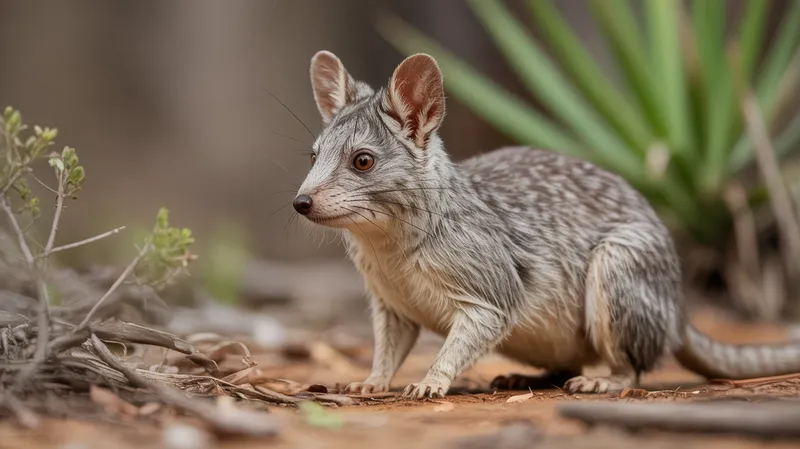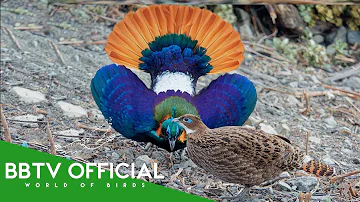
Woylie
Bettongia penicillata

Meet the Woylie
The Woylie, also known as the Brush-tailed Bettong, is a small, nocturnal marsupial native to southwestern Australia. Distinctive for its slender build and bushy black-tipped tail, the Woylie plays a crucial ecological role as a soil engineer, dispersing fungi and seeds while foraging. Once widespread, its population has dramatically declined due to habitat loss, predation, and disease, making it one of Australia's most threatened mammals. With a soft gray-brown coat and large, rounded ears, the Woylie is shy and mostly active at night, sheltering by day in well-constructed nests of grass and leaves.
Classification
Mammal
Habitat
Dry sclerophyll forest and woodland
Diet
Herbivore
Lifespan
4-6 years
Conservation
Critically Endangered
Weight
1-1.8 kg
📖Fascinating Facts
Nocturnal Lifestyle
Woylies are primarily active at night, foraging under the cover of darkness and avoiding predators.
Marsupial Relatives
Woylies are closely related to kangaroos and wallabies, but are much smaller, belonging to the Potoroidae family.
Eco-Engineers
By digging for fungi and roots, Woylies aerate the soil and help with seed dispersal, benefiting entire ecosystems.
📋Detailed Description
The Woylie (Bettongia penicillata) is a small marsupial, typically weighing between 1.0 and 1.7 kg and measuring 29–38 cm in head-body length, with a distinctive prehensile tail of 30–36 cm that is bushy and black-tipped. Its fur is soft and dense, colored grey-brown dorsally with a paler underbelly. The Woylie’s hind limbs are elongated and well-muscled, adapted for saltatory (hopping) locomotion, while its forelimbs are short but strong, equipped with sharp claws for digging. Nocturnal and elusive, the Woylie spends daylight hours in dome-shaped nests constructed from grasses, bark, and leaves, often hidden under dense vegetation or fallen logs. It is a solitary forager but may share nest sites or feeding areas with conspecifics, especially during the non-breeding season. The species is a mycophagist, specializing in the consumption of underground fungi (truffles), but its diet also includes tubers, seeds, roots, and invertebrates. Woylies play a keystone ecological role by dispersing fungal spores and aerating soil through their digging, which enhances nutrient cycling and plant regeneration. Their large, rounded ears provide acute hearing, aiding in predator detection. Females possess a well-developed forward-opening pouch where they rear their young, and both sexes exhibit a keen sense of smell for locating food underground.
💡 Did you know?
A single Woylie can turn over as much as 4 tonnes of soil in a year, significantly shaping its habitat and aiding in forest regeneration.
🔬Research & Sources
Wikipedia Summary
The woylie or brush-tailed bettong is a small, near threatened mammal native to forests and shrubland of Australia. A member of the rat-kangaroo family (Potoroidae), it moves by hopping and is active at night, digging for fungi to eat. It is also a marsupial and carries its young in a pouch. Once widespread, the woylie mostly died out from habitat loss and introduced predators such as foxes and feral cats. It is currently restricted to two small areas in Western Australia. There were two subspecies: B. p. ogilbyi in the west, and the now-extinct B. p. penicillata in the southeast.
Last Modified: 5/28/2025
🎭Behavior & Social Structure
Woylies are strictly nocturnal, emerging from their nests shortly after dusk to forage throughout the night. They exhibit a home range of approximately 5–25 hectares, depending on habitat quality and resource availability. Foraging is characterized by rapid, purposeful hopping interspersed with frequent stops to dig for food, often leaving small conical pits in the soil. Woylies are generally solitary but may display loose social structures, with overlapping home ranges and occasional communal nesting, particularly among females. They communicate through soft vocalizations, scent marking, and physical cues. Territorial disputes are rare, but males may display aggression during the breeding season. Woylies exhibit strong nest fidelity, returning to the same nest for several nights unless disturbed. Their foraging activity is influenced by moonlight and weather, with reduced activity during bright or wet nights to avoid predation.
👶Reproduction & Life Cycle
Woylies are polyoestrous and can breed year-round, though reproductive peaks are often observed in late winter and spring, coinciding with increased food availability. Courtship involves brief chases and vocalizations, with dominant males securing mating opportunities. Gestation lasts approximately 21 days, after which a single, altricial joey is born and immediately crawls into the mother's pouch. Pouch life extends for about 100–105 days, followed by a further 40–60 days of dependence in the nest. Females can become pregnant again shortly after giving birth, exhibiting embryonic diapause—a reproductive strategy that allows delayed implantation until the pouch is vacated. Parental care is provided solely by the female, who grooms and protects the joey until weaning at around 4–5 months. Sexual maturity is reached at 6–7 months for females and 8–9 months for males.
🛡️Adaptations & Survival
The Woylie’s prehensile tail is a unique adaptation among marsupials, enabling it to carry nesting material and food items. Its robust forelimbs and sharp claws are specialized for digging, facilitating access to subterranean fungi and tubers. The species’ mycophagous diet is supported by an elongated, sensitive snout and acute olfactory senses for detecting food underground. Nocturnality reduces exposure to diurnal predators and heat stress, while cryptic coloration provides camouflage in the dappled light of woodlands. The construction of well-insulated nests helps maintain stable microclimates and reduces predation risk. Embryonic diapause allows reproductive flexibility in unpredictable environments, ensuring population persistence during adverse conditions.
📚Research Sources
🎨Cultural Significance
The Woylie holds significance in Indigenous Australian culture, where it is known by various names in local languages and features in traditional stories as a clever and industrious animal. Historically, its fur was occasionally used for ceremonial purposes, and its digging behavior was recognized as beneficial for soil health. In contemporary Australia, the Woylie has become a flagship species for conservation, symbolizing the plight of small marsupials and the importance of ecosystem restoration. It is featured in educational programs and community conservation initiatives.
🔬Recent Research & Discoveries
Recent research has focused on the Woylie’s role as an ecosystem engineer, demonstrating its importance in fungal spore dispersal and soil turnover, which benefit plant communities and overall ecosystem function. Genetic studies have revealed low diversity in remnant populations, highlighting the need for genetic management in translocation programs. Ongoing telemetry and camera-trap studies are improving understanding of habitat use, movement patterns, and predator interactions. Disease ecology research is investigating the impact of protozoan parasites and their role in population declines. The Woylie is also a model species for studying the effects of rewilding and predator-proof fencing in Australian conservation.
🎥Wildlife Videos

Wildlife - The Fascinating World of Wild Animals | Full Series | Free Documentary Nature
Wildlife - The Fascinating World of Wild Animals | Wildlife Documentary Watch 'Ocean Stories - Full Series' here: ...
Free Documentary - Nature

30 Most Beautiful Creatures On Earth (Order Galliformes) | Wildlife Documentary | BBTV Official
In the heart of the world's most remote forests and rugged highlands, where mist lingers over ancient trees and the wilderness ...
BBTV Official

3 Hours of The Untold Stories of British Wildlife | Our World
A wildlife documentary series, narrated by Hugh Bonneville, uncovering the hidden lives of animals across diverse habitats ...
Our World

THE LAST MIGRATION | A Journey Across Africa’s Forgotten Wilderness #naturedocumentaries
THE LAST MIGRATION | A Journey Across Africa's Forgotten Wilderness #naturedocumentaries Welcome to THE LAST ...
WILD NATURE - Nature animal documentary

Sanctuary life causing critically endangered woylies to lose their street smarts | ABC News
ABC News provides around the clock coverage of news events as they break in Australia and abroad, including the latest ...
ABC News (Australia)

Wildcats - A Global Journey | Full Series | Free Documentary Nature
Wildcats - A Global Journey | Full Series | Wildlife Documentary Watch 'Wild Canada - Nature's Untamed Beauty | Full Series' ...
Free Documentary - Nature
🌍Habitat Information
The Woylie typically inhabits Dry sclerophyll forest and woodland environments. Woylies have adapted to their environments with specialized features and behaviors.
Primary Habitat:
Dry sclerophyll forest and woodland
More detailed habitat information will be available soon.
🛡️Conservation Status
The Woylie is currently classified as Critically Endangered. Conservation efforts are crucial for preserving this species for future generations.
Common Threats:
- 🏠Habitat loss and fragmentation
- 🌡️Climate change impacts
- 🎯Hunting and poaching
- 🏭Human-wildlife conflict
⚠️Threats & Conservation Challenges
The Woylie faces severe threats from introduced predators, particularly the European red fox (Vulpes vulpes) and feral cats (Felis catus), which have caused catastrophic population declines since the 20th century. Habitat loss and fragmentation due to land clearing, agriculture, and altered fire regimes have further restricted its range. Emerging diseases, such as trypanosome infections, have been implicated in recent population crashes. Small, isolated populations are vulnerable to genetic bottlenecks and stochastic events. Despite intensive conservation efforts, including predator control, habitat restoration, and translocation programs, the species remains Near Threatened (IUCN) and is listed on CITES Appendix I. Current population estimates suggest fewer than 20,000 mature individuals, with most confined to fenced reserves or intensively managed sites in southwestern Western Australia.
🔬Scientific Classification
Scientific Name
Bettongia penicillata
Classification Hierarchy
🔍 About Taxonomic Classification
Taxonomic classification is a hierarchical system used by scientists to classify and organize living organisms based on shared characteristics and evolutionary relationships.
The system moves from broad categories (Kingdom) to increasingly specific ones, with each animal's scientific name typically consisting of its Genus and species.
📝Community Notes
Share your observations and insights about the Woylie with our community of wildlife enthusiasts.
Join Our Community
Sign in to share your observations and connect with fellow wildlife enthusiasts.
Sign In to ContributeNo community notes yet
Be the first to share your observations about the Woylie!
Explore Woylie
Select a tab above to learn more about this amazing animal.
📸Photo Gallery
No photos available for this animal yet.
🌟Discover More Wildlife
Continue your journey of discovery with more fascinating animals from our database
